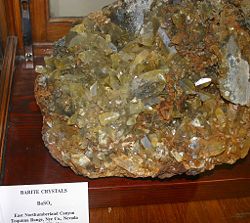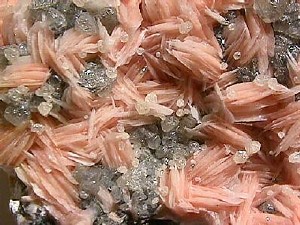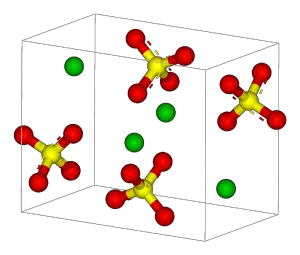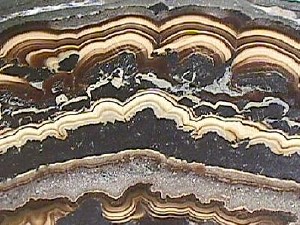Difference between revisions of "Barite" - New World Encyclopedia
| Line 1: | Line 1: | ||
{{Claimed}} | {{Claimed}} | ||
[[Image:barite09.jpg|thumb|right|250px|Large barite crystals from Nevada.]] | [[Image:barite09.jpg|thumb|right|250px|Large barite crystals from Nevada.]] | ||
| − | [[Image:Baryte Morocco.jpg|thumb|right| | + | [[Image:Baryte Morocco.jpg|thumb|right|Crystals of barite (pink) mixed with cerussite (clear) from Morocco.]] |
| − | + | [[Image:Barite-unit-cell-3D-balls.png|thumb|right|The unit cell in barite crystals.]] | |
| − | [[Image:Barite-unit-cell-3D-balls.png|thumb| | + | [[Image:Baryte Poland.jpg|thumb|right|Barite (cream and brown bands) with galena (silvery) and hematite from Poland.]] |
| − | '''Barite''' ([[Barium|Ba]][[Sulfur|S]][[Oxygen|O]]<sub>4</sub>) | + | '''Barite''' (British spelling '''Baryte''') is a [[mineral]] consisting of [[barium sulfate]] ([[Barium|Ba]][[Sulfur|S]][[Oxygen|O]]<sub>4</sub>). It is generally white or [[color]]less, and is the main source of barium. The mineral is also called '''heavy spar'''. |
| + | |||
| + | == Occurrence == | ||
Barite commonly occurs in lead-zinc veins in [[limestone]]s, in hot spring deposits, and with [[hematite]] ore. It is often associated with the minerals [[anglesite]] and [[Celestine (mineral)|celestine]]. | Barite commonly occurs in lead-zinc veins in [[limestone]]s, in hot spring deposits, and with [[hematite]] ore. It is often associated with the minerals [[anglesite]] and [[Celestine (mineral)|celestine]]. | ||
| − | The name barite is derived from the [[Greek language|Greek]] word ''βαρύς'' | + | == Etymology and History == |
| + | |||
| + | The name barite is derived from the [[Greek language|Greek]] word ''βαρύς'', meaning "heavy." The radiating form, sometimes referred to as Bologna Stone, attained some notoriety among [[Alchemy|alchemists]] for the [[phosphorescent]] specimens found in the 1600s near [[Bologna, Italy]] by [[Vincenzo Cascariolo]]. | ||
| + | |||
| + | == Characteristics == | ||
| + | |||
| + | Barite has a [[Mohs hardness]] of 3. Its [[refractive index]] is 1.63, its [[specific gravity]] is in the range of 4.3-5. Its [[crystal structure]] is [[orthorhombic]]. | ||
| + | |||
| + | == Uses == | ||
| + | |||
| + | In [[commerce]], the mineral is sometimes referred to as "barytes." The term "primary barite" refers to the first marketable product, which includes crude barite (run of mine) and the products of simple beneficiation methods, such as washing, jigging, heavy media separation, tabling, flotation, and magnetic separation. Most crude barite requires some upgrading to minimum purity or density. Barite that is used as an aggregate in a "heavy" [[cement]] is crushed and screened to a uniform size. Most barite is ground to a small, uniform size before it is used as a filler or extender, an addition to industrial products, or a weighting agent in [[petroleum]] well [[drilling fluid|drilling mud]]. | ||
| + | |||
| + | Barite is used in the manufacture of paints and paper. | ||
| + | |||
| + | == Precautions == | ||
| − | + | Although barite contains barium, which is a "heavy" metal, it is not considered a [[toxic]] chemical by most governments because of its extreme [[solubility|insolubility]]. | |
== References == | == References == | ||
| Line 27: | Line 43: | ||
==External links== | ==External links== | ||
| − | * [http://www.mindat.org/min-549.html | + | * [http://minerals.usgs.gov/minerals/pubs/commodity/barite/ Barite: Statistics and Information.] ''U.S. Geological Survey''. Retrieved April 13, 2007. |
| − | * [http://webmineral.com/data/Barite.shtml | + | * [http://www.mindat.org/min-549.html Baryte.] ''Mindat.org''. Retrieved April 13, 2007. |
| − | * [http://www.isbc.unibo.it/Files/10_SE_BoStone.htm | + | * [http://webmineral.com/data/Barite.shtml Barite Mineral Data.] ''Webmineral.com''. Retrieved April 13, 2007. |
| + | * [http://www.isbc.unibo.it/Files/10_SE_BoStone.htm The Discovery of Luminescence: "The Bolognian Stone."] ''University of Bologna''. Retrieved April 13, 2007. | ||
[[Category:Physical sciences]] | [[Category:Physical sciences]] | ||
Revision as of 16:13, 13 April 2007
Barite (British spelling Baryte) is a mineral consisting of barium sulfate (BaSO4). It is generally white or colorless, and is the main source of barium. The mineral is also called heavy spar.
Occurrence
Barite commonly occurs in lead-zinc veins in limestones, in hot spring deposits, and with hematite ore. It is often associated with the minerals anglesite and celestine.
Etymology and History
The name barite is derived from the Greek word βαρύς, meaning "heavy." The radiating form, sometimes referred to as Bologna Stone, attained some notoriety among alchemists for the phosphorescent specimens found in the 1600s near Bologna, Italy by Vincenzo Cascariolo.
Characteristics
Barite has a Mohs hardness of 3. Its refractive index is 1.63, its specific gravity is in the range of 4.3-5. Its crystal structure is orthorhombic.
Uses
In commerce, the mineral is sometimes referred to as "barytes." The term "primary barite" refers to the first marketable product, which includes crude barite (run of mine) and the products of simple beneficiation methods, such as washing, jigging, heavy media separation, tabling, flotation, and magnetic separation. Most crude barite requires some upgrading to minimum purity or density. Barite that is used as an aggregate in a "heavy" cement is crushed and screened to a uniform size. Most barite is ground to a small, uniform size before it is used as a filler or extender, an addition to industrial products, or a weighting agent in petroleum well drilling mud.
Barite is used in the manufacture of paints and paper.
Precautions
Although barite contains barium, which is a "heavy" metal, it is not considered a toxic chemical by most governments because of its extreme insolubility.
ReferencesISBN links support NWE through referral fees
- Farndon, John. 2006. The Practical Encyclopedia of Rocks & Minerals: How to Find, Identify, Collect and Maintain the World's best Specimens, with over 1000 Photographs and Artworks. London: Lorenz Books. ISBN 0754815412.
- Klein, Cornelis, and Barbara Dutrow. 2007. Manual of Mineral Science. 23rd ed. New York: John Wiley. ISBN 978-0471721574.
- Pellant, Chris. 2002. Rocks and Minerals. Smithsonian Handbooks. New York: Dorling Kindersley. ISBN 0789491060.
- Shaffer, Paul R., Herbert S. Zim, and Raymond Perlman. 2001. Rocks, Gems and Minerals. Rev. ed. New York: St. Martin's Press. ISBN 1582381321.
- Mineral Gallery. 2006. The Mineral Barite. Amethyst Galleries. Retrieved April 13, 2007.
External links
- Barite: Statistics and Information. U.S. Geological Survey. Retrieved April 13, 2007.
- Baryte. Mindat.org. Retrieved April 13, 2007.
- Barite Mineral Data. Webmineral.com. Retrieved April 13, 2007.
- The Discovery of Luminescence: "The Bolognian Stone." University of Bologna. Retrieved April 13, 2007.
Credits
New World Encyclopedia writers and editors rewrote and completed the Wikipedia article in accordance with New World Encyclopedia standards. This article abides by terms of the Creative Commons CC-by-sa 3.0 License (CC-by-sa), which may be used and disseminated with proper attribution. Credit is due under the terms of this license that can reference both the New World Encyclopedia contributors and the selfless volunteer contributors of the Wikimedia Foundation. To cite this article click here for a list of acceptable citing formats.The history of earlier contributions by wikipedians is accessible to researchers here:
The history of this article since it was imported to New World Encyclopedia:
Note: Some restrictions may apply to use of individual images which are separately licensed.



